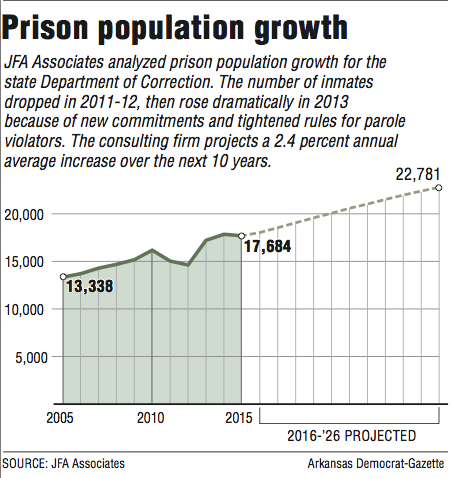The state should expect to see its inmate population continue climbing, according to a consultant's finding that prompted correctional officials to discuss options Thursday ranging from better use of parole to sentencing changes and even new prisons.
On Thursday, the Board of Corrections -- which oversees the state's prison and parole agencies -- received its second annual report from JFA Associates, a corrections analysis group that predicted that Arkansas' inmate population will climb about 2.4 percent a year and increase from 17,684 inmates last year to 22,781 by 2026.
That estimate, delivered by JFA analyst Wendy Ware, is short of the worst-case projection of 25,671 that she gave the state last year.
But courts continue to send criminals to prisons, and -- since the state changed its parole policies in 2013 -- more people who violate the conditions of their paroles are being sent back to state lockups. Both practices continue to drive up the inmate population.
"So, we are going to grow. It's just a matter of how much?" asked Board of Corrections commissioner Mary Parker-Reed.
"That's correct," Ware said. "Unless there are dramatic changes to the system."
"I don't believe there's anything that dramatic [we could do] that we could not grow," Parker-Reed said.
"It would take something major," Ware said.
The prison population started to drop after Act 570 was enacted in 2011. That law changed some thresholds for felony crimes and allowed for some administrative actions to keep some offenders out of lockups.
But in 2013, an eight-time parole absconder, Darrell Dennis, kidnapped and killed a Fayetteville teenager in Little Rock.
That case prompted the Board of Corrections to tighten parole policies. The result was the biggest one-year jump that she had ever seen in a state's incarceration rate, Ware stated.
The jump was because parolees were not complying with the new policies and were being sent back to prison. In 2012, Ware noted, there were 1,726 parolees returned to prison. That rose to 4,005 in 2013 and to 5,082 in 2015.
During last year's presentation of prison growth projections, Ware said the best the state could hope for was a population of 20,689 by 2025, which assumed a "flat" growth rate in new admissions to prison.
That flat growth hasn't happened.
In 2012, the courts sent 4,437 offenders to prison. In 2015, that figure was 5,524.
The increase is largely driven by more women sentenced to prison, Ware said. In 2012, 523 women were sent to state lockups. That figure was 931 in 2015.
"That's three years. And that's a trend," Ware said. "This is a big number, and it's very substantial. It's very substantial given the smaller, less-housing options for females, so it should be focused on."
Ware commended the Parole Board and parole officials for working to curb parole revocations, actions that she said have helped "stabilize" the state's prison growth rate.
But she warned that the 22,781 figure that she projected for 2026 is based on the assumption that those efforts continue. It also assumes that judges and prosecutors continue to pursue slightly shorter sentences for offenders, something that also has contributed to a slowdown in the growth of prison rolls.
Benny Magness, head of the Board of Corrections, said it sounded like "all the stars need to align" in order to keep prison numbers at the projected levels.
Commissioner Buddy Chadick said that's a "big if" and that it's time to start talking about a new prison to house the growing number of inmates.
"Yes, we're all conscientious of taxes," Chadick said. "We just can't do nothing. We've even shipped them to [a private jail in] Texas. But they're our inmates."
Ahead of the 2015 legislative session, Magness supported building a new 1,000-bed prison at a cost of as much as $150 million, but legislators and Gov. Asa Hutchinson disagreed that a new prison was necessary.
Commissioner Bobby Glover pondered aloud Thursday about how much longer the prison population growth would be sustainable.
"There's no question we're one runaway train right now," Glover said. "So far we haven't gotten any support to build a new prison. So consequently, if you don't have a place to put them, the alternative is to get a lot softer on crime."
A task force of lawmakers, corrections officials and mental-health providers -- created by Hutchinson -- has been studying the growth trends for about a year.
So far, it is recommending that the state invest in more parole and probation officers, who average about 129 cases per worker, as a way to reduce recidivism and lower prison rolls.
On Thursday, Magness said it will take combined efforts beyond hiring more parole officers to help keep the growth from exceeding projections.
As for "major" changes like revising state sentencing laws or parole policies, Magness shrugged.
He said past efforts by his board -- like seeking to ease sentencing requirements for methamphetamine offenders -- have been shut down by the Legislature.
"I don't know if there is one out there," Magness said of a solution. "I believe, at some point, we have to revisit" talk of a new prison.
A Section on 07/01/2016
